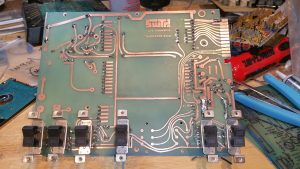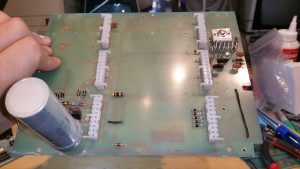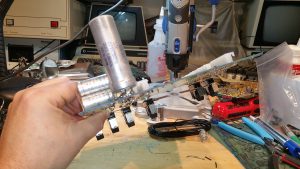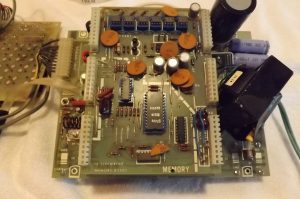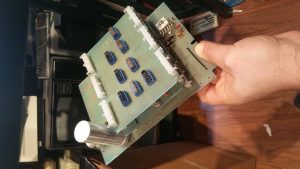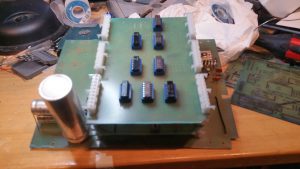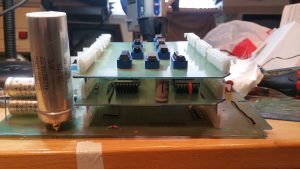Progress continues on my TV Typewriter Redux project. After encountering disaster in the form of weak traces, I cleaned up and readied my second TVT mainframe board (there were three, thankfully I got one right!). It looks great – the dye isn’t quite as blue as on the last one and it looks about as vintage as I think one can make modern PCB stock look.
I don’t yet have the transformer, fuse clips, or self test posts. I’m also missing two momentary return DPDT switches. But I’ve installed pretty much everything else. The mainframe is easy to work on – everything is spaced out nicely.
Moving up the unit I started work on the Cursor board. I had run out of old 14 pin sockets from my parts bin, so I hunted ebay and found these blue Cambion wire wrap sockets. I don’t know what year they’re from but to me they look a lot like the ones my new friend Roy used on his TVT:
You can see Roy installed them only for certain ICs. I suspect this was a decision based on what was likely to fail, and what components were too expensive to risk when doing self-tests and/or diagnostics. But where he used sockets, they are those nice, tall blue ones. I don’t know if they’re wirewrap — doubt it — but I can just install my wirewraps and trim the legs and get the same look. Here they are installed with ICs in place.
I didn’t exist yet in 1973 but I think that looks pretty authentic if I do say so myself!
You’ll note I also did a test fitment, plugging the Cursor into the Timing board and then the Mainframe underneath. It had occurred to me that if the Mainframe scan was skewed there was every likelihood the others were as well. But I had hoped because I made sure to compare the three smaller boards before etching them that they would work.
I can’t say they fit perfectly, but they can be made to fit, and continuity is perfect between boards. I can easily trace connections from a pin up top to where it ends up on the mainframe. Excellent! One small beef – although the first board plugs nicely and snug into the mainboard, the others sit up about a quarter inch from the molex connectors beneath. I figured out this was because I had soldered the pins in such a way that they were actually pressing against the bottom of the molex connectors, restricting how far the pins from above could penetrate. I’m not sure if I’ll attempt to remedy this at all, or just trim the pins on each board to compensate. Hmm…

